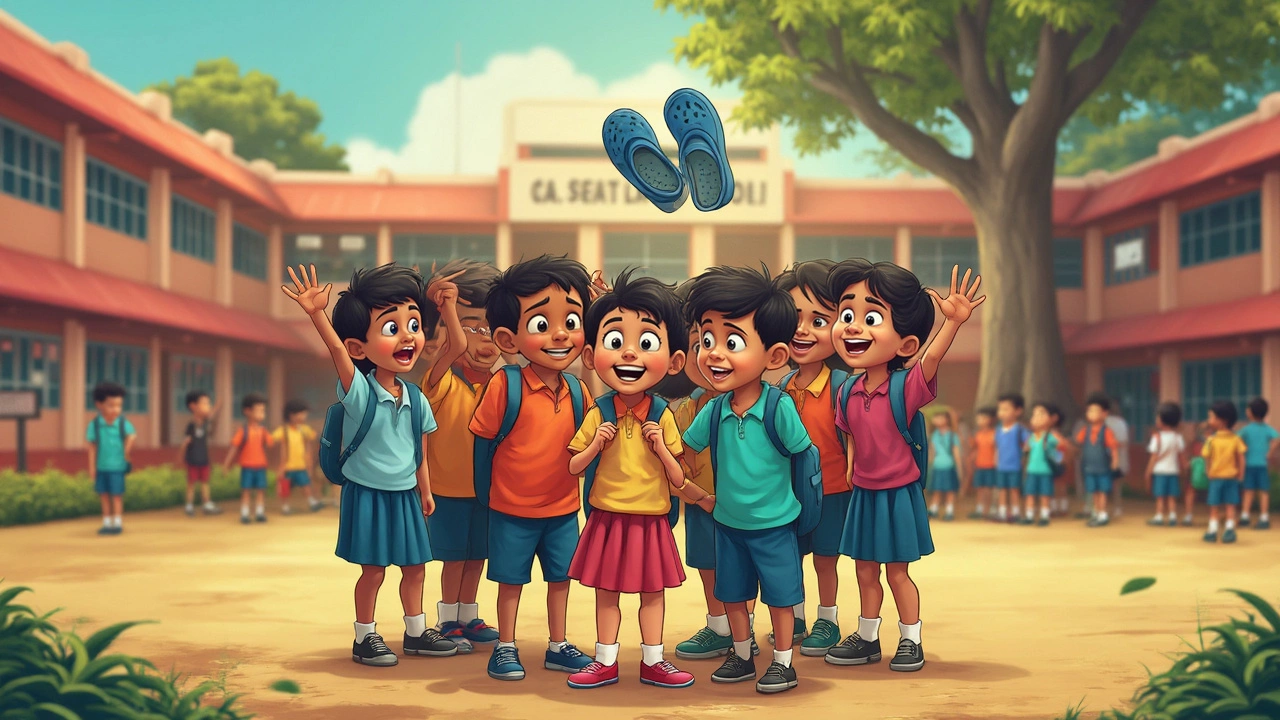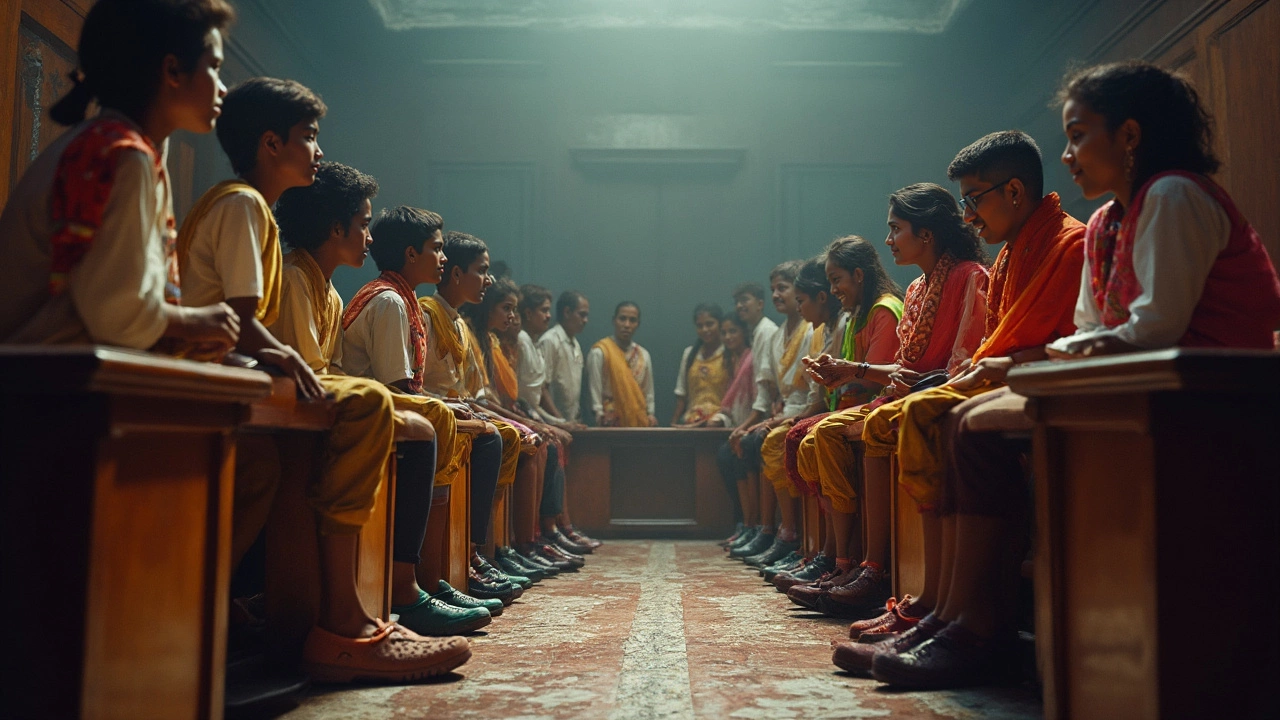Why are Schools Banning Crocs?

Who would have thought that Crocs would find themselves on the banned list in some schools? They're comfy, colorful, and easy to slip on, making them a favorite for many kids and, let's be honest, adults too. But with schools sweeping these popular shoes under the rug, it's time to explore what's going on.
First off, let's talk about safety. While Crocs might seem like the perfect fit for a school day, their open-back style and lack of ankle support turn out to be a big no-no on playgrounds and corridors. It's a bit easy to trip or even twist an ankle in these comfy clogs without some proper back support.
- The Popularity of Crocs
- Safety Concerns
- Uniformity and Dress Codes
- What Schools Are Saying
- Parental Reactions
- Finding the Right School Shoes
The Popularity of Crocs
If you thought Crocs were just a fad from the mid-2000s, think again. They've seen a major resurgence over recent years, becoming a beloved staple in casual and even work settings. From farmers to nurses, many swear by the comfort factor. The design might seem a bit quirky, but for many, it's this very quirkiness that makes Crocs appealing.
One reason for their popularity is their versatility. Available in a rainbow of colors and endless patterns, they enable individual expression—something that's especially appealing to students. Plus, those little charms, or 'Jibbitz', are a big hit, letting wearers customize their pair with everything from animals to favorite characters.
Beyond aesthetics, their practicality is hard to beat. Made from a lightweight foam material, these shoes are water-resistant and super easy to clean—perfect for kids who love jumping into puddles or getting messy in the art room.
As for pricing, they're fairly affordable compared to other brand-name shoes. And they're everywhere! You can't walk through a shopping mall or browse online marketplaces without spotting a pair.
| Year | Sales (millions of units) |
|---|---|
| 2020 | 69.6 |
| 2022 | 103.5 |
A noteworthy fact: according to company reports, Crocs sold over 103 million pairs globally in 2022 alone. Clearly, they're not just a trend; they're a movement.
But as many kids proudly walk into school, proudly flaunting their neon orange or bright pink Crocs, little do they realize that their favorite footwear might soon face the wrath of school dress codes. And that's where the controversy begins.
Safety Concerns
So, why are Crocs getting the boot in schools? One word: safety. Schools have raised alarms about how these comfy shoes might actually be hazardous. The key issue here is that Crocs don't provide the ankle support needed for running around in playgrounds or bustling through crowded halls. It's not just about the shoes slipping off—there's a genuine risk of falls and injuries.
Stories of kids tripping on stairs or getting their toes caught in doors have led to some serious discussions among educators. In fact, some schools noted an uptick in minor accidents linked directly to these easy-going clogs. The reality is, versatility in footwear isn't just about comfort, especially when it involves scrap knees or twisted ankles.
Another thing to consider is that Crocs are made from a foam resin, which can be too slick for smooth surfaces. There have been anecdotes from teachers who’ve seen students take unintended slides on wet linoleum floors or polished tiles. Yikes!
Supporting Stats
Maybe this will hit home a bit: a study in 2023 showed that around 12% of minor school injuries came from inadequate footwear, with Crocs being a common culprit. These numbers have pushed schools to reevaluate what’s suitable for a hustling bustling school environment.
All these factors have made educational institutions rethink their dress codes when it comes to footwear. The goal is to ensure a safe space for learning and play. So, while those bright and breezy Crocs might be a hit for lounging at home or a walk in the park, they might need to stay out of the classrooms for now.
Uniformity and Dress Codes
Schools have long been sticklers for dress codes. These guidelines help maintain a sense of unity and equality among students. While some folks remember strict uniforms from their school days, many modern schools allow slightly more flexibility—except when it comes to footwear.
Why are Crocs getting a cold shoulder? It's partly about maintaining a consistent look. Imagine a classroom full of students wearing bright, mismatched footwear. It throws off that sense of uniformity, making it harder to enforce any sort of dress code. Schools often argue that this lack of consistency can be distracting.
Another point is preparation for the workplace. Schools aspire to prep students for the real world, where many jobs require specific attire and work shoes. Even though kids might not think twice about their footwear now, setting standards can teach them about presentation.
Balancing Comfort and Rules
Students slam the idea, arguing their beloved Crocs are just too comfortable to give up. Let's face it, when you're running from class to class, cozy feet are almost a necessity. But is style over substance?
Schools suggest alternatives like sneakers or closed-toe shoes that balance comfort and adherence to guidelines. This way, students can stay comfortable without clashing with the school's dress code ethos.
So while banning Crocs might seem like overkill to some, it's tied up in these bigger ideas about equality, focus, and future work readiness.

What Schools Are Saying
Schools have been quite vocal about their reasons for banning Crocs. The main concern is safety, which is a priority for every educational institution. You've got kids running around, jumping off playground equipment, and generally being kids, and footwear plays a bigger role in their safety than you might think.
One school district in Ontario did a study last year and found a 15% increase in minor foot injuries when students wore open-back shoes, like Crocs, during outdoor activities. This prompted a revision of the dress code, stating that 'all students must wear closed-toe shoes with back support to school.' Schools are looking for uniformity as well. Dress codes are in place not just for safety but also to maintain a standard look. Crocs, with their wild colors and unique shape, stick out like a sore thumb in a sea of sneakers and traditional school shoes.
Footwear isn't just about making sure students are not in pain; it's about making sure they have one less thing to worry about. Schools argue that a standardized dress code helps students focus more on learning and less on fashion.
However, not every school is jumping on the 'ban Crocs' bandwagon. Some still allow them for indoor use or on specific days. It seems there isn't a one-size-fits-all policy, and schools are making individual decisions based on their unique environments and needs.
Parental Reactions
Parents have been having quite the chat about the banning of Crocs in schools. For many, these rubbery shoes were a lifesaver on busy school mornings. Easy to slip on and pretty durable, kids loved the funky colors, and parents appreciated the practicality.
However, some parents are split over the issue. Safety first, right? Some totally understand where the schools are coming from, especially when they hear stories of kids tripping or scrambling on stairs. It’s hard to argue against keeping kids safe, even if it means switching shoes.
Then there's the group of parents who feel the ban is a step too far. They argue that if dress codes are too restrictive, it squashes kids' creativity and personal expression. A few have even voiced concerns about the financial impact. Let's face it, not all parents can easily afford to buy entirely new sets of shoes just to fit in with school rules.
Parents are finding themselves caught between these two perspectives. On community forums, you'll see loads of suggestions on alternative types of shoes, discussions about dress code policies, and questions about whether these bans are even enforceable.
In the end, everyone seems to agree on the importance of safety, but there’s still a lot of debate around how much control schools should have over what kids wear. Many parents are advocating for a happy medium – shoes that are safe but still allow kids to express themselves.
Finding the Right School Shoes
Choosing the right shoes for school isn't just about fashion—it's about combining style with practicality, something every parent wants for their kids. So, what should you look for when the school's laying down the law against Crocs?
Comfort First
Let’s face it, kids love comfortable shoes. Look for shoes with cushioning that can withstand long school days. Sneakers with a good sole and breathable material are often a safe bet. They keep those little toes happy, especially when running between classes or during recess.
Safety Matters
Safety is a biggie. Opt for shoes with closed toes and sturdy grips to prevent slips and falls. Shoes with velcro straps or laces can offer better support compared to slip-ons, reducing flex points that might cause accidents.
Dress Code and Style
Follow the school's dress code but don’t sacrifice style over compliance. Many schools allow certain styles and colors within guidelines, so you can still find trendy shoes that are approved. Neutral colors like black, brown, or navy tend to be safe choices.
Durability is Key
Kids can be rough on their shoes. Invest in shoes made from durable materials that can withstand wear and tear. Leather and high-grade synthetics are known to last longer. Check stitching and soles to ensure they look like they can endure a bit of scuffing from everyday adventures.
| Feature | Benefit |
|---|---|
| Non-slip soles | Prevent falls |
| Adjustable straps | Better fit |
| Neutral colors | Dress code compliant |
| Breathable material | Enhanced comfort |
With so many choices, it's easier than you think to find school-approved shoes that your kid will actually want to wear. It might take a bit of convincing to give up those Crocs, but with the right pair, they won’t miss them for long!